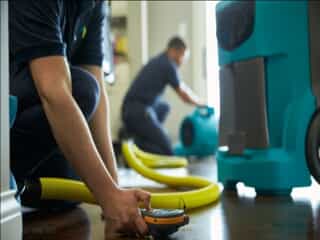The Total Guide to Water Damage Remediation and What to Anticipate
Water damage can be a substantial worry for both home owners and company owner, often bring about considerable repair demands and unanticipated costs. Understanding the intricacies of water damage reconstruction is essential for efficient recovery, from assessing the source of the issue to applying appropriate reconstruction techniques. This guide aims to clear up each action of the process, highlighting prospective obstacles and offering safety nets. The journey through reconstruction is not always simple, and certain subtleties may occur that need cautious consideration. What are these obstacles, and how can they impact your reconstruction experience?
Understanding Water Damages
Water damage can usually be categorized into 3 classes: tidy water, grey water, and black water. Clean water stems from uncontaminated resources, such as leaky pipelines or rains, while gray water has minor impurities, typically from home appliances like dishwashers or washing equipments.
The extent of water damage is further categorized right into four classifications based on the extent of saturation and the materials impacted. Course 1 includes very little damages to a tiny location, while Class 4 suggests specialized drying out methods are required for products like wood or plaster because of their high absorption ability. Understanding these categories aids remediation specialists examine the situation accurately and establish the essential reduction approaches.
Prompt recognition of the water resource and damages level is crucial for preventing second issues such as mold and mildew growth or architectural damage. Appropriate analysis and classification ensure that suitable strategies and resources are utilized, helping with a more efficient restoration process.
Preliminary Actions to Take
In the after-effects of water damage, a property owner's speedy action is important to minimize further issues - Water Damage Restoration Fairfield County. The primary step is to make certain safety and security; shut off the electrical energy in the affected area to avoid electric shock. If the water source is still energetic, such as a broken pipe, turned off the major water system immediately to stop more flooding
When security is ensured and paperwork is complete, start getting rid of any standing water. Usage buckets, mops, or a wet/dry vacuum cleaner to remove as much water as possible.
After getting rid of standing water, it's essential to dry the area thoroughly. Speak to a professional water damages repair service to deal with the damage and examine, making sure a comprehensive strategy to healing.
The Repair Refine

Adhering to the assessment, water extraction is executed making use of industrial-grade pumps and vacuums. As soon as the water is eliminated, the drying process begins.
After drying, the remediation team focuses on cleansing and sanitizing the locations affected by water. The last stage includes repair services and reconstruction, where damaged materials such as insulation, drywall, and flooring are replaced or fixed.
Typical Difficulties Encountered
Water damages restoration frequently offers numerous obstacles that can make more complex the healing process. One substantial difficulty is the extent of the damage, which can vary extensively based upon the resource of the water and the period of direct exposure. Classifications of water damage, such as tidy, grey, or black water, require various approaches and safety and security protocols, making complex restoration efforts.
One have a peek at these guys more obstacle is the capacity for mold and mildew growth. If water-damaged locations are not dried swiftly, mold and mildew can establish within 24 to 48 hours, providing wellness threats and needing additional removal actions. Architectural integrity is likewise a worry; water can jeopardize wall surfaces, ceilings, and floor covering, leading to costly repairs or substitutes.
Furthermore, the emotional toll on property owners can prevent the decision-making procedure. Anxiety and anxiety might shadow judgment, making it challenging to navigate the restoration procedure successfully. Control with insurance business can be difficult, as house owners typically face conflicts and delays relating to coverage. Recognizing these challenges is crucial for both remediation specialists and impacted individuals, making certain a much more efficient reaction to water damage occurrences.
Tips for Prevention
Preventing water damages is a proactive technique that can considerably reduce the risk of experiencing the difficulties previously reviewed. To effectively secure your building, normal maintenance and cautious tracking are important.

First, inspect your pipes system regularly for leakages or signs of rust. Immediately attend to any problems to prevent little leakages from rising into substantial water damage. In addition, make sure that downspouts and gutters are clear of debris to assist in correct drainage away from your home's structure.
2nd, mount water detection tools in crucial locations such as bathrooms and cellars. click to read These tools can alert you to leakages before they create extensive damage. Furthermore, consider using sump pumps in areas prone to flooding.

Lastly, produce a thorough emergency situation plan that includes shut-off treatments for your main water supply. By taking these preventative actions, you not only safeguard your building but also conserve time and monetary resources that would certainly otherwise be invested on reconstruction efforts.

Final Thought
Understanding of the kinds and sources of water damages, along with the obstacles that may develop throughout the repair procedure, is essential for effective end results. By understanding the extensive nature of water damage reconstruction, home proprietors can much better browse the recovery procedure and protect their financial investments.
Water damages can generally be categorized right into three classes: clean water, grey water, and black water. Tidy water stems from uncontaminated sources, such as leaking pipelines or rains, while grey water consists of small contaminants, commonly from devices like dish washers or cleaning machines. If the water resource is still active, such as a damaged pipe, shut off the primary water supply promptly to stop further flooding.
Call a professional water damages restoration solution to assess and deal with the damage, making sure a comprehensive method to healing - Water Damage Restoration Fairfield County. Groups of water damage, such as tidy, grey, or black water, require various strategies and security methods, making complex restoration efforts